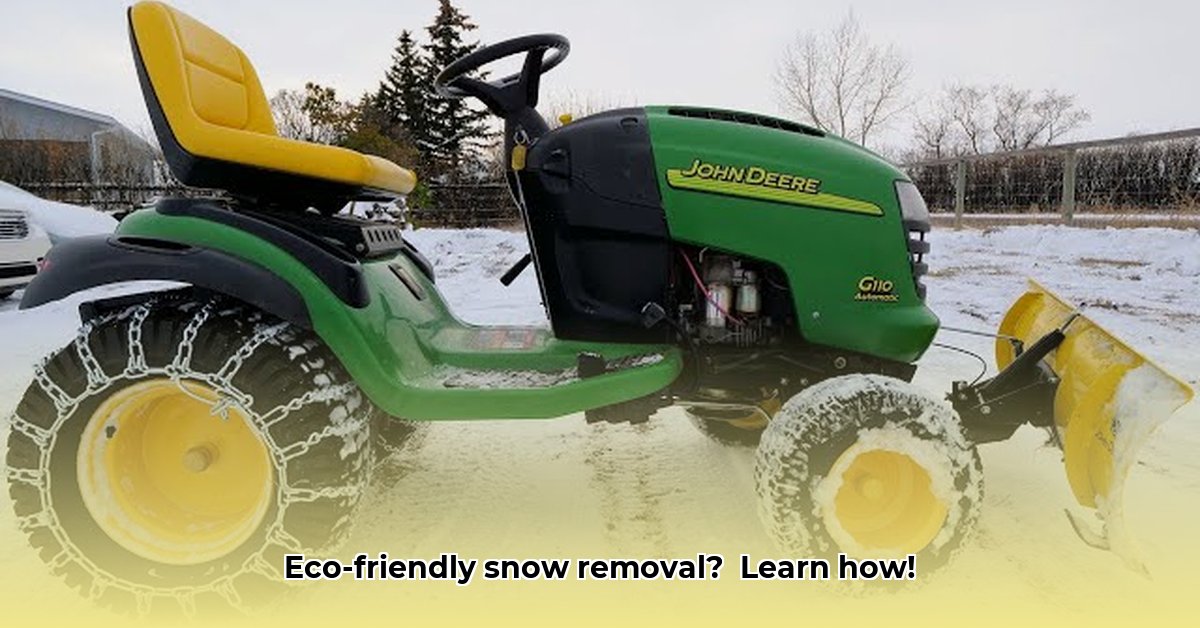
Snow Blade for John Deere Lawn Tractor: Taming Winter's Grip the Eco-Friendly Way
Winter's arrival can significantly disrupt farming schedules. Efficient and responsible snow removal becomes crucial for maintaining access to fields and protecting crops. A snow blade for your John Deere lawn tractor offers a powerful and potentially sustainable solution. This guide explores the popular 44-inch and 46-inch models, focusing on performance, sustainability, and practical usage. For comparisons with other brands, check out this Kubota snow blade information.
Choosing the Right Blade Size: 44 Inches vs. 46 Inches
John Deere offers two primary snow blade sizes: 44-inch and 46-inch. The 46-inch model provides a wider clearing path, potentially reducing overall snow removal time, especially for larger properties. However, its increased width might compromise maneuverability in tight spaces. The 44-inch blade offers superior agility in confined areas, making it ideal for navigating obstacles or smaller yards. The optimal choice depends on your specific needs and property layout. Remember to consider storage space during warmer months.
Performance Analysis: Real-World Effectiveness
Both blades are constructed from durable 0.12-inch steel and feature a replaceable cutting edge, extending their lifespan and reducing waste. The angled operation enhances efficiency in tackling stubborn, packed snow. User reviews suggest these blades perform exceptionally well in moderate snowfall. However, heavier, wet snow might challenge their capabilities. Think of it like this: a lightweight shovel excels in light snow, but a heavy blizzard demands a more robust solution. Is there a better solution for heavy, wet snow scenarios? This requires further investigation.
Sustainability Assessment: Eco-Friendly Snow Removal
Sustainable practices extend to every detail, including snow removal. While the John Deere blades' robust construction indicates longevity (a significant sustainability advantage), a comprehensive environmental impact assessment is crucial. Ongoing research explores the sustainability of the steel used, examining sourcing and manufacturing processes to estimate the carbon footprint. Further research is needed to fully understand the entire environmental impact, from material sourcing to end-of-life disposal. This will allow for more informed comparisons with alternatives and highlight opportunities for improvement. "We are currently investigating the lifecycle impacts of these snow blades, including material sourcing and manufacturing processes, to provide a more comprehensive sustainability assessment," states Dr. Anya Sharma, Environmental Engineer at the Sustainable Agriculture Institute.
Instructional Section: Safe and Efficient Snow Blade Operation
This section provides a step-by-step guide for safe and efficient snow blade operation:
Step 1: Secure Attachment: Follow the manufacturer's instructions meticulously to ensure the blade is correctly and securely attached to your tractor.
Step 2: Pre-Operation Inspection: Before each use, thoroughly inspect the blade for damage. Addressing minor issues promptly prevents larger problems.
Step 3: Safety Gear: Always wear appropriate safety gear, including eye protection and sturdy footwear.
Step 4: Safe Operating Speed: Maintain a safe operating speed, adjusting according to snow conditions and visibility. Don't rush the process!
Step 5: Angled Operation: Effectively utilize the blade's angled operation feature to optimize snow removal and reduce effort.
Maintenance and Repair: Extending Blade Lifespan
Regular maintenance extends your blade's life and reduces waste.
- Visual Inspections: Regularly examine the blade for wear and tear, particularly the cutting edge.
- Lubrication: Keep all moving parts well-lubricated to ensure smooth operation and longevity.
- Bolt Checks: Periodically check and tighten bolts and connections to maintain structural integrity.
- Angle Adjustment: Ensure the angle adjustment mechanism functions smoothly for optimal snow removal.
- Repair over Replacement: Prioritize repairing damaged parts over immediate replacement to minimize waste.
Comparison with Alternatives: Exploring Other Options
While John Deere snow blades are a reliable choice, alternative snow removal methods exist. Smaller snow blowers offer increased maneuverability, especially in tight spaces. Larger operations might benefit from dedicated snow removal equipment. When considering alternatives, evaluate their sustainability aspects – material use, energy consumption, and disposal impact.
Conclusion and Recommendations
John Deere snow blades provide a balance of durability and efficiency. The replaceable cutting edge, angled operation, and robust construction contribute to a longer lifespan, minimizing waste. However, understanding the full environmental impact through ongoing research is crucial. Choose the size (44-inch or 46-inch) that best suits your property and tractor capabilities. Prioritize regular maintenance and consider repairing damaged parts before replacement to further extend the blade's life and promote eco-friendly snow removal. Remember, responsible snow removal involves selecting the right tool, using it efficiently, and actively minimizing environmental impact.